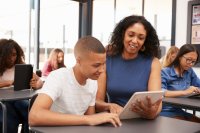Can 360-Degree Feedback Empower Students and Teachers?
Student-teacher professional development can not only improve practices but also build trust and strengthen relationships.
Your content has been saved!
Go to My Saved Content.Feedback for K-12 teachers is often offered by coaches, administrators or other educators. Teachers adjust their styles and strategies based on the critiques and praise of other adults—but in one high school school in Des Moines, IA, recently highlighted by EdWeek, teachers get assessment straight from the source: students.
More than 100 students at Theodore Roosevelt High School offered candid feedback to their teachers as part of an innovative professional development program. “Students are openly encouraged to ‘push back on the adults,’” according to reporter Denisa R. Superville who covered the new student-teacher professional development program. The school is highly diverse and has been plagued by high absenteeism rates and “the largest achievement gap between black and white students in the district.” Students provide critiques of everything from curriculum to discipline practices. They also help “shape the redesign of the school's mission and vision statement” the piece noted.
This type of comprehensive, 360-degree feedback is more often seen in corporate contexts, where a movement towards flatter organizational structures has emerged as a way to democratize the workplace and give more voice to workers at every level. For teachers, the process might not feel like professional development in the traditional sense, but it closes an often forgotten feedback loop, providing a space for authentic review and assessment that gives students a meaningful way to interact with their teachers—and perhaps even to improve their own learning opportunities, in turn.
Some students suggested brain breaks so they would be less tempted to look at their phones during lessons. Others asked for slower pacing and more visual aids. That feedback is valuable, but one of the strongest assets of the program is the way it allows students and teachers to break down walls and see each other as unique—and sometimes flawed—individuals with personal lives full of triumphs and struggles.
Connecting on a personal level made a noticeable change for one student named Zion Freeman and his math teacher. “If he's late for class, his teacher now asks if he's had lunch,” the article noted, “and when she is absent, Zion said he worries if she or her husband, who last year was undergoing cancer treatment, are OK.”
Ninth grade school improvement coach Mindy Euken spoke about the importance of these connections: "We said to the staff 'We really want you to consider what types of cultural wealth you are hearing the students speak to you from their lived experiences; in what ways can they navigate systems that you may be unable to because their lived experiences is different; or what linguistic abilities or strengths they have or that they bring into the school?’"
The improvements in teaching techniques are a valuable outcome of the joint professional development program, but perhaps the most important effect of this collaboration is the relationship building and personal understanding between teachers and students. Those strengthened bonds offer a stronger foundation of cultural sensitivity across the community.
